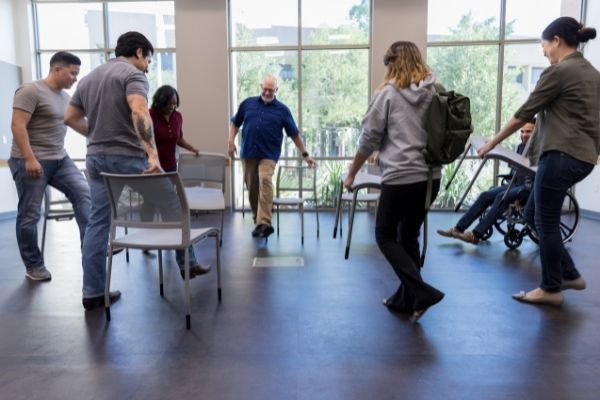Narcotics Anonymous was created in 1953 to serve those recovering from any and all types of addiction (as opposed to Alcoholics Anonymous, which had been around for 20 years already, but solely focused on getting over alcoholism). This was the first organization of its type, one that offered a peer-based support group for users of often illegal drugs who before, had few other places to turn. Considering attending an NA meeting for the first time? This quick guide to the Narcotics Anonymous meeting format will tell you what to expect.
The Narcotics Anonymous Meeting Format
Narcotics Anonymous allows its chapters to run almost completely autonomously. As a result, there is bound to be some variation in how meetings are conducted. Aside from following the basic principles, meeting groups are allowed to adapt and change as they wish and conduct themselves in various ways (more on that later). However, there are still plenty of things that these meetings have in common, namely how the beginning and end of meetings are conducted.
-
1. Greeting
Once the meeting has begun, a person will open with a moment of silence as well as a recitation of the ‘we’ version of the Serenity Prayer. Afterward, the speaker will ask for first-timers and you may be asked to introduce yourself (you will not be forced to participate if you don’t wish to).
2. Readings
Every meeting will call on volunteers to read five foundational texts:
- Who is an addict
- What is the NA Program
- Why are we here
- How it works
- The Twelve Traditions of NA
3. Secretary Report
This includes announcements, events, updates, and anything else that pertains to a group’s operation.
4.Discussion
There are various types of discussion formats in Narcotics Anonymous meetings. Some encourage participation from multiple attendees while others are limited to one primary speaker. This is usually determined by the chairperson of the group.
5. Key tags
Key tags are similar to that of AA chips. These are color-coded keyrings that indicate how long a person has been sober. During this portion of the meeting, one of the leaders will announce a certain duration of time (30 days, 9 months, etc.) and call for individuals who have been sober for that corresponding period to get a key tag.
Key tag color meanings
- White: Less than 30 days sober
- Orange: More than 30 days sober
- Green: 60 days sober
- Red: 90 days sober
- Blue: 6 months sober
- Yellow: 9 months sober
- Glow in the dark: 1 year sober
- Gray: 18 months sober
- Black: Multiple years sober
6. Break
Members can talk with other members, step outside, etc.
7. Passing the basket
Narcotics Anonymous is a fully self-sufficient organization that only accepts donations from its members. First-time NA meeting participants are not expected to give any money, this is only for established members.
8. Reading of the 12th Tradition
9. Prayer (Optional)
For those who wish to participate, meetings will conclude with another reading of the Serenity Prayer along with ‘Just For Today’ and the third step prayer.
Types of Narcotics Anonymous Meetings
Narcotics Anonymous is closely modeled after its predecessor and as such, NA meetings are centered around confidentiality and non-judgemental support. The literature that’s read, the types of discussions held, and even who’s allowed to attend the meeting, are all variables that can affect the format of the meeting.
Discussion vs. Speaker Meetings
All NA meetings have some element of discussion, the amount of which can vary. Some have a looser, open-sharing format where anyone can speak. This is considered a discussion meeting. Others might have a guided discussion based on certain topics or NA literature led by the chairperson (one of the more senior members of the group who are part of the volunteers who operate the meetings). Then there is what’s known as a speaker meeting, where a single person speaks for the majority of the session.
These meeting formats can be broken down even further, in the way that some of the discussions are conducted. There are round-robin meetings where individuals take turns speaking in a circle; tag meetings where one speaker picks the next person to speak, and even stick meetings where individuals draw a topic to speak on.
Open vs. Closed Meeting
First is the classification of whether a meeting is considered ‘open’ or ‘closed’. Open meetings mean that anyone is welcome to attend, including non-drug users such as friends and family members. Closed meetings, on the other hand, are restricted in attendance only to those who are struggling with addiction or otherwise have a drug use problem. Find a meeting near you today.

Hi My name is john.I am an L.M.H.C and LADAC.Im looking for some creative games for group meetings.